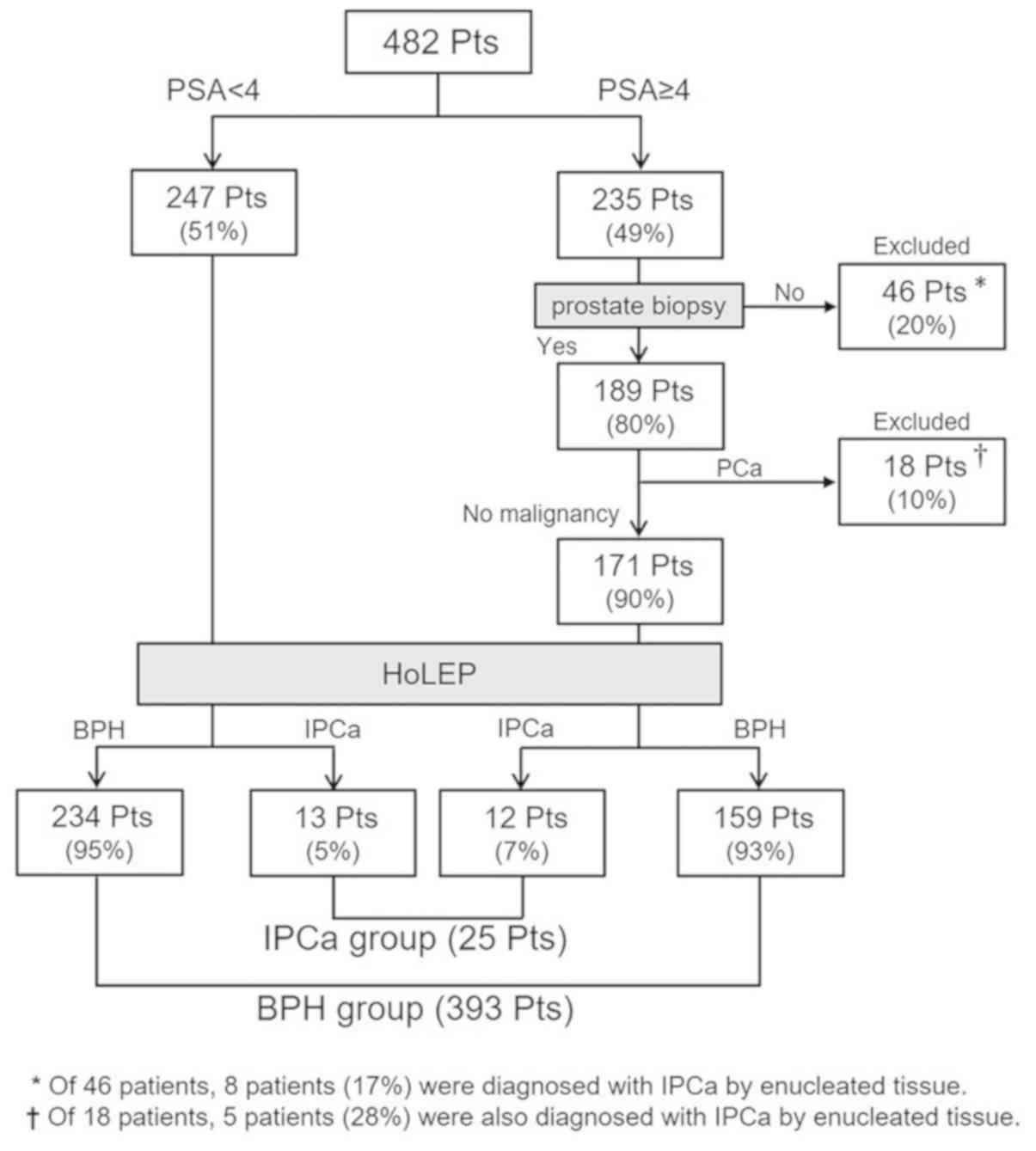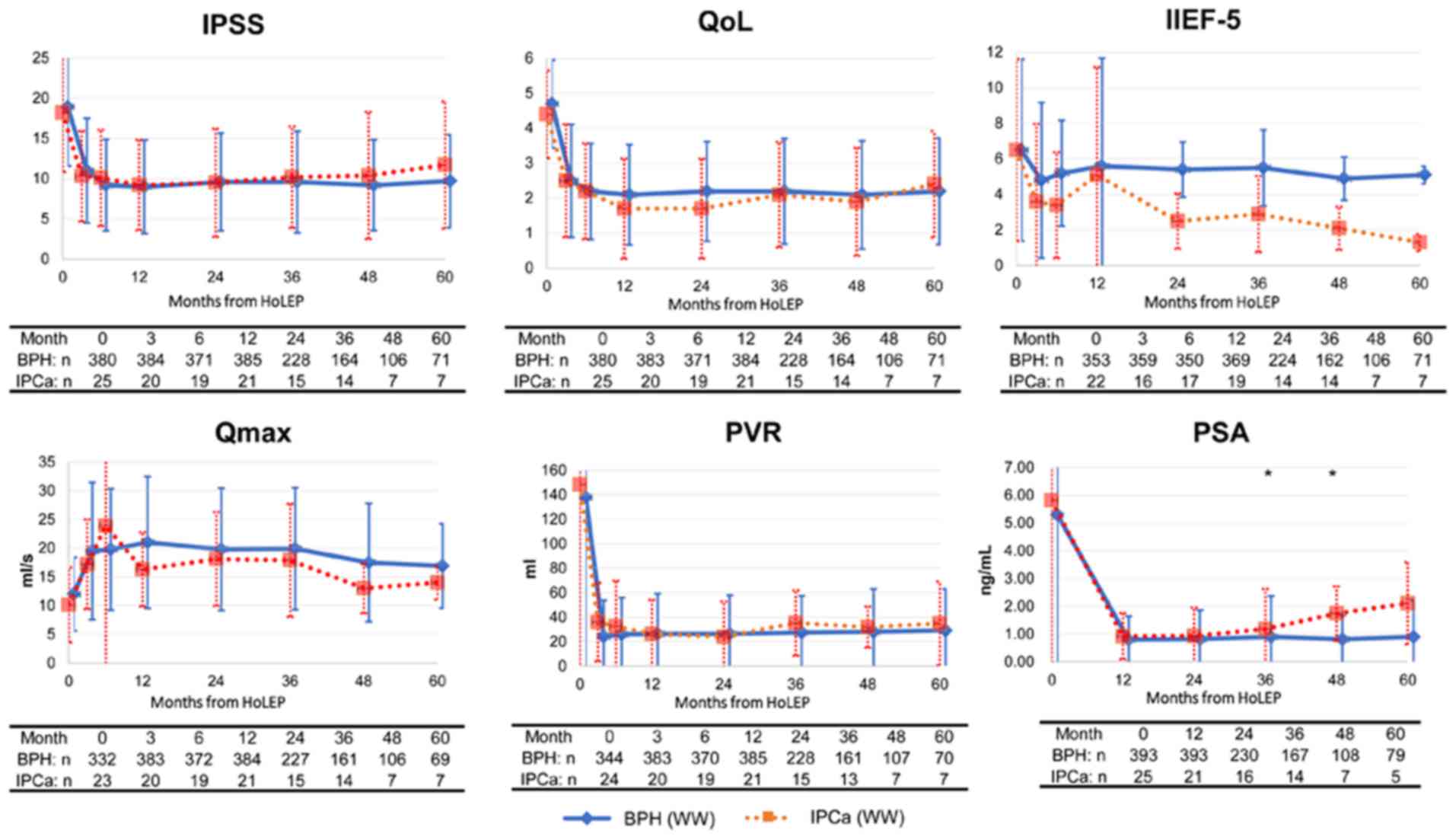|
1
|
Adolfsson J: The management of category
T1a-T1b (incidental) prostate cancer: Can we predict who needs
treatment. Eur Urol. 54:16–18. 2008. View Article : Google Scholar : PubMed/NCBI
|
|
2
|
Zigeuner RE, Lipsky K, Riedler I, Auprich
M, Schips L, Salfellner M, Pummer K and Hubmer G: Did the rate of
incidental prostate cancer change in the era of PSA testing? A
retrospective study of 1127 patients. Urol. 62:451–455. 2003.
View Article : Google Scholar : PubMed/NCBI
|
|
3
|
Jones JS, Follis HW and Johnson JR:
Probability of finding T1a and T1b (incidental) prostate cancer
during TURP has decreased in the PSA era. Prostate Cancer Prostatic
Dis. 12:57–60. 2009. View Article : Google Scholar : PubMed/NCBI
|
|
4
|
Otsubo S, Yokomizo A, Mochida O, Shiota M,
Tatsugami K, Inokuchi J and Naito S: Significance of
prostate-specific antigen-related factors in incidental prostate
cancer treated by holmium laser enucleation of the prostate. World
J Urol. 33:329–333. 2015. View Article : Google Scholar : PubMed/NCBI
|
|
5
|
Bhojani N, Boris RS, Monn MF, Mandeville
JA and Lingeman JE: Coexisting prostate cancer found at the time of
holmium laser enucleation of the prostate for benign prostatic
hyperplasia: Predicting its presence and grade in analyzed tissue.
J Endourol. 29:41–46. 2015. View Article : Google Scholar : PubMed/NCBI
|
|
6
|
Elkoushy MA, Elshal AM and Elhilali MM:
Incidental prostate cancer diagnosis during holmium laser
enucleation: Assessment of predictors, survival, and disease
progression. Urology. 86:552–557. 2015. View Article : Google Scholar : PubMed/NCBI
|
|
7
|
Kim M, Song SH, Ku JH, Oh SJ and Paick JS:
Prostate cancer detected after Holmium laser enucleation of
prostate (HoLEP): Significance of transrectal ultrasonography. Int
Urol Nephrol. 46:2079–2085. 2014. View Article : Google Scholar : PubMed/NCBI
|
|
8
|
Ohwaki K, Endo F, Shimbo M, Fujisaki A and
Hattori K: Comorbidities as predictors of incidental prostate
cancer after Holmium laser enucleation of the prostate: Diabetes
and high-risk cancer. Aging Male. 20:257–260. 2017. View Article : Google Scholar : PubMed/NCBI
|
|
9
|
Rosenhammer B, Lausenmeyer EM, Mayr R,
Burger M and Eichelberg C: Holmium laser enucleation of the
prostate provides similar incidental prostate cancer detection
rates as open prostatectomy: A matched pair analysis. Urol Int.
101:382–386. 2018. View Article : Google Scholar : PubMed/NCBI
|
|
10
|
Elzayat EA and Elhilali MM: Holmium laser
enucleation of the prostate (HoLEP): long-term results, reoperation
rate, and possible impact of the learning curve. Eur Urol.
52:1465–1471. 2007. View Article : Google Scholar : PubMed/NCBI
|
|
11
|
Alkan I, Ozveri H, Akin Y, Ipekci T and
Alican Y: Holmium laser enucleation of the prostate: Surgical,
functional, and quality-of-life outcomes upon extended follow-up.
Int Braz J Urol. 42:293–301. 2016. View Article : Google Scholar : PubMed/NCBI
|
|
12
|
Fayad AS, Elsheikh MG, Zakaria T, Elfottoh
HA, Alsergany R, Elshenoufy A and Elghamarawy H: Holmium laser
enucleation of the prostate versus bipolar resection of the
prostate: A prospective randomized study. ‘pros and cons’. Urology.
86:1037–1041. 2015. View Article : Google Scholar : PubMed/NCBI
|
|
13
|
Cornu JN, Ahyai S, Bachmann A, de la
Rosette J, Gilling P, Gratzke C, McVary K, Novara G, Woo H and
Madersbacher S: A systematic review and meta-analysis of functional
outcomes and complications following transurethral procedures for
lower urinary tract symptoms resulting from benign prostatic
obstruction: An update. Eur Urol. 67:1066–1096. 2015. View Article : Google Scholar : PubMed/NCBI
|
|
14
|
Nunez R, Hurd KJ, Noble BN, Castle EP,
Andrew PE and Humphreys MR: Incidental prostate cancer revisited:
Early outcomes after holmium laser enucleation of the prostate. Int
J Urol. 18:543–547. 2011. View Article : Google Scholar : PubMed/NCBI
|
|
15
|
Becker A, Placke A, Kluth L, Schwars R,
Isbarn H, Chun F, Heuer R, Schlomm T, Seiler D, Engel O, et al:
Holmium laser enucleation of the prostate is safe in patients with
prostate cancer and lower urinary tract symptoms-A retrospective
feasibility study. J Endurol. 28:335–341. 2014. View Article : Google Scholar
|
|
16
|
Lin WY, Chang YH, Lin CL, Kao CH and Wu
HC: Erectile dysfunction and the risk of prostate cancer.
Oncotarget. 8:52690–52698. 2017.PubMed/NCBI
|
|
17
|
Elmansy HM, Elzayat EA, Sampalis JS and
Elhilali MM: Prostatic-specific antigen velocity after holmium
laser enucleation of the prostate: Possible predictor for the
assessment of treatment effect durability for benign prostatic
hyperplasia and detection of malignancy. Urology. 74:1105–1110.
2009. View Article : Google Scholar : PubMed/NCBI
|
|
18
|
Rivera ME, Frank I, Viers BR, Rangel LJ
and Krambeck AE: Holmium laser enucleation of the prostate and
perioperative diagnosis of prostate cancer: An outcomes analysis. J
Endourol. 28:699–703. 2014. View Article : Google Scholar : PubMed/NCBI
|
|
19
|
Lee DH, Chung DY, Lee KS, Kim IK, Rha KH,
Choi YD, Chung BH, Hong SJ and Kim JH: Clinical experiences of
incidental prostate cancer after transurethral resection of
prostate (TURP) according to initial treatment: A study of a Korean
high volume center. Yonsei Med J. 55:78–83. 2014. View Article : Google Scholar : PubMed/NCBI
|
|
20
|
Meeks JJ, Maschino AC, McVary KT and
Sandhu JS: Clinically significant prostate cancer is rarely missed
by ablative procedures of the prostate in men with prostate
specific antigen less than 4 ng/ml. J Urol. 189:111–115. 2013.
View Article : Google Scholar : PubMed/NCBI
|











